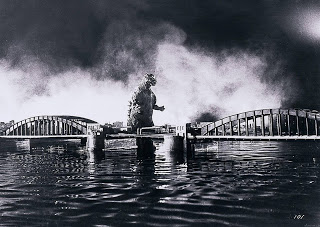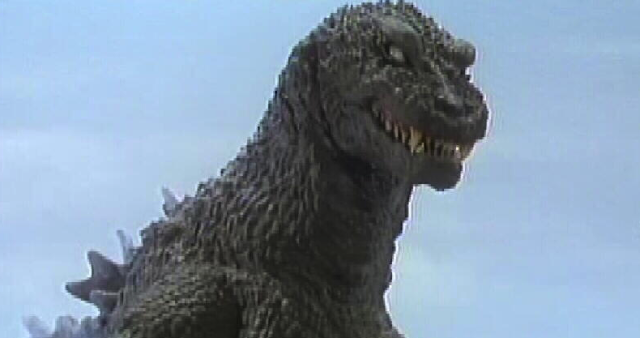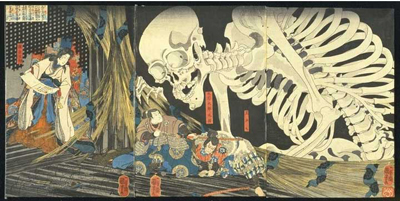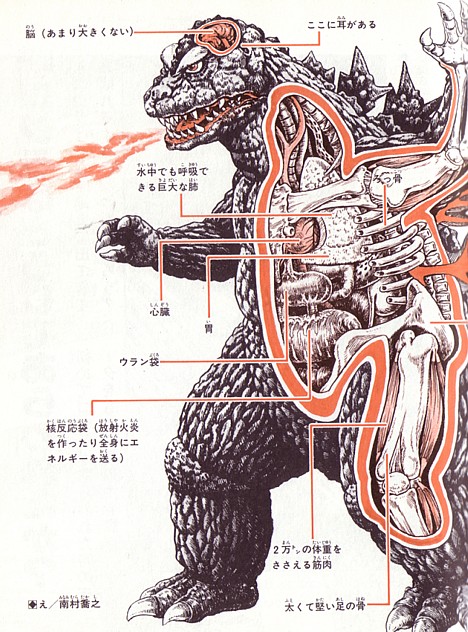Godzilla. King of the Monsters.
The name itself transcends the globe like so few movie made monsters can.
So much has been said about this beast that it’s hard to know where to add something new.
Each film has been analyzed and examined by his legion of fans the world over that no nuance has been left unturned.
So what’s been missed?
Well, no one’s quite looked at Godzilla as a whole before. Most analysis of his thematic value focuses on his individual use in a film.
But his overarching thematic value is something a bit harder to find.
Godzilla is well known as a metaphor for nuclear weapons, and has been through a lot of his career.
“. . . Godzilla lives on and on because he can always be reborn in whatever guise works best for the time, and be invested with greater significance suits our psychological needs.”
– John J. Pierce
But no matter what the source, the specter of nuclear energy lingers on.
First seen as dangerous and unpredictable, it became controllable and a source for good. Then, towards the end of the Gold War, he reverted to being dangerous as the price of nuclear power was revealed. Now, he is something of an anti-hero, much like Nuclear Energy is.
Godzilla can defend and help us, but there is an inherent danger in him that cannot be ignored.
“As long as the arrogance of mankind exists, Godzilla will survive.”
– Tomoyuki Tanaka
However, there are other times when Godzilla’s symbolism screamed something else entirely.
Director Shushuke Kaneko, who did wonderful things reviving Gamera for the new millennium, was given the job of directing a Godzilla film. Though not given the time he wanted, he tapped into a symbolic aspect of the beast that no other director had yet acknowledged. This led his Godzilla to be something other than an irradiated dinosaur, and beyond the other god-monsters like Rodan and Mothra.
This Godzilla was a reminder of the War in horrific ways.
The Godzilla of Godzilla, Mothra, King Ghidorah: Giant Monsters All Out Attack (It really DOES sound better in Japanese: Gojira, Mosura, Kingu Ghidorah: Daikaiju Soukujeki) was the dead.
It was everyone who died in the pacific theater of World War II. From those killed in atrocities committed in China against its people (testing bubonic plague bio weapons being just the tip of the iceberg of a history few want to acknowledge) to their own dead soldiers.
One side angry for being killed in a total war, the other for being betrayed—they went to die thinking Japan would see victory of death.
Instead, Japan surrendered rather than face the death that they did. The director got this idea from interviewing people who saw the original film and asked what it meant to them.
And that was their answer.
Godzilla was the amalgamation of those souls into one spot of revenge. Its breath weapon upgraded to a true atomic blast, leaving mushroom clouds in its wake.
This Godzilla, out of all its incarnations, this was the most evil.
And it’s not unprecedented in Japan’s mythology either. The Gashadokuro is a giant ghost monster, appearing as a skeleton some 15 times larger than a human. This ghost was not formed by a single spirit, but by an amalgamation of those who died in starvation.
It also bites the heads off those it can catch. Japanese ghosts are very mean.
Biology
Believe it or not, his biology has been extensively covered.
Aside from what I already talked about in previous articles regarding huge things (Short version: Godzilla HAS to be armored like a mountain in order to stand, let alone do anything else—making the squishy American “Godzilla” more unrealistic than his Japanese counterpart), Doctor Kenneth Carpenter, Director of the USU Eastern Prehistoric Museum and published paleontologist, did a mock article that analyzed Godzilla from a paleontological standpoint (as well as giving the best scientific explanation for what the Oxygen Destroyer actually did that I’ve ever seen).
Godzilla was the spark that led him to Paleontology and the Tokyo native even named a Triassic therapod after the king of monsters (though further study might render the genus a “Nomen Dubia” like Brontosaurus).
Paleontology has advanced since then and a few things have been re-classified, but there’s little doubt to a few things.
Godzilla is a very primitive dinosaur, retaining 4 fingers on his claws in all appearances. Ken Carpenter identified his closest relative as Ceratosaurus, which shares the finger count as well as a row of scutes along his back. More advanced Ceratosaurs became known as Abelisaurs, the best known among them being Carnataurus, which shares Godzilla’s short and stocky face in many of his early appearances.
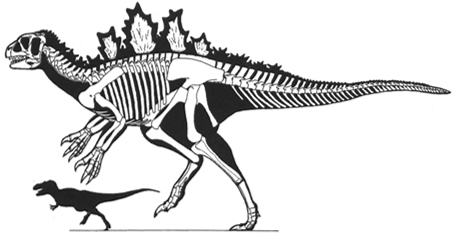 |
| Scale illustration: Godzilla vs. T-Rex |
However, in his first appearance and his appearances from 1984 through 1995, Godzilla has 4 toes instead of the 3 found on Dinosaurs. This has lead one well known YouTube user, geology student and cladogram fan AronRa, to label the original Godzilla as something closer to squamata (lizards) rather than dinosaurs as the ankles were, well, all wrong.
Why? Well, Godzilla’s flat footed, while dinosaurs and most of their early relatives walked on their toes.
Dinosaurs are actually defined by 3 very specific things: the number of muscle bearing holes in their heads; their hip/leg connecting joins; and their ankles. Lack any one of those, and it’s not a true dinosaur.
Godzilla also has several other features that are non-dinosaurian, such as small pointed ears in his first and 1984-1995 appearances.
That later form also has a second row of teeth and held prominent fangs in many of his appearances. Millennium and later appearances make his jaws longer and more crocodilian, giving him a stronger resemblance to Spinosaurus, which shared Godzilla’s semi-aquatic habits (though it was primarily a fish eater, hunting sharks and sawfish in river deltas).
It’s hard to determine what he is, really, due to the effects of heavy mutation.
Hell, the 1984-1995 Godzilla actually absorbed radiation as a food source, powered by an internal nuclear reactor. This brings up his various super powers: fire breath and regeneration being the primary pair. Other powers have waxed and waned over time, including generating pulses of radiation from his body to flying on his fire breath like a jet.
G-Fans like to pretender that never happened (though I think it was just hilarious).
The regeneration of Godzilla is frightening no matter the incarnation—ranging from recovering an eye to ignoring being sliced in half with an energy sword. Most extreme regenerators are very primitive (which eases healing), but to combine healing complex organs like the eye with frightening speed would absolutely require an energy source on par with a nuclear reactor to fuel.
The fire breath has, like Godzilla, taken many forms over the years.
The two primary mutations ones being a direct energy weapon, while the earlier form takes the form of a jet of gas. Now, expelling gasses is something far more realistic and done by just about every animal in existence. Many enthusiasts of dragons speculated a biological function for fueling a fire breathing monster being the ignition of a methane gas, expelled in a rather large, noxious burp.
However, Godzilla’s is less flame oriented and more stream of gas, as though it were compressed inside his body as a byproduct of either nuclear chain reaction (if powered by a reactor) or through normal digestive functions.
This would be a set of specialized organs indeed, and his mouth would have to be hardened to withstand the temperatures/radioactivity which can set buildings ablaze and turn metal tanks red with heat.
Probably smells about as nice, though.



































































































